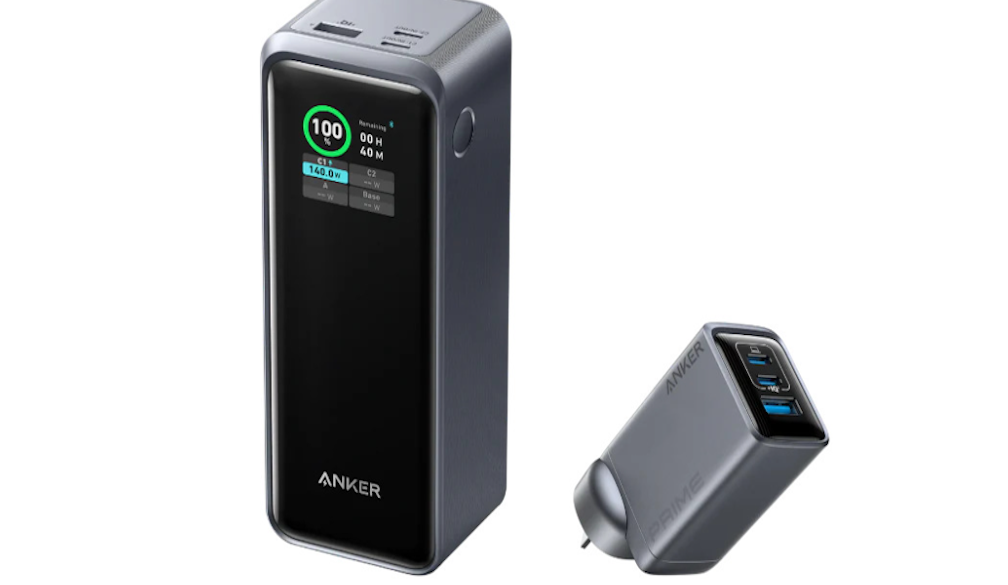5 Best Laptop Power Banks for Remote Workers and Travelers

Finding the best laptop power bank is essential for remote workers and travelers who need to stay powered up anytime, anywhere. Whether you’re working from a beachside cafe or catching a flight across the country, a reliable portable charger ensures that your laptop, phone, and other devices are always ready when you need them most.
In this article, we'll explore the 5 best power banks for laptop, compare their specs, pros, and cons, and help you make an informed decision. Plus, we’ll give you quick tips on how to choose the best portable power bank for travel based on your needs.
How to Choose the Best Portable Power Bank for Travel
Selecting the right power bank for travel and remote work involves balancing capacity, portability, compatibility, and safety. Here are key factors to consider:
Capacity (mAh or Wh):
- Choose a capacity between 20,000mAh and 27,000mAh (up to 100Wh) to comply with TSA airline regulations for carry-on luggage. This allows multiple charges for laptops, smartphones, and other devices. Higher capacity provides more charges but increases weight.
Power Output (Wattage):
- For laptops, select a power bank with at least 65W output via USB-C Power Delivery (PD). Modern laptops like MacBooks or gaming laptops may require 100W or more for optimal charging.
- Verify compatibility with your device’s charging requirements (check voltage and amperage).
Portability:
- Prioritize compact and lightweight designs for travel. A power bank weighing under 1.5 pounds with a slim form factor is ideal for fitting into bags or laptop sleeves.
- Built-in cables or retractable features enhance convenience.
Ports and Multi-Device Charging:
- Multiple ports (USB-C, USB-A) enable simultaneous charging of laptops, phones, and accessories. Look for power banks that maintain high output across ports.
- Features like pass-through charging (charging the power bank while it charges devices) are useful for limited outlets.
Charging Speed (Input/Output):
- Fast recharging (e.g., 65W or 100W input) reduces downtime. A power bank that recharges in under 2 hours is ideal for travelers.
- Ensure support for fast-charging protocols like PD 3.0 or PPS for compatibility with modern devices.
Safety Features:
- Choose models with overcharge protection, short-circuit prevention, and temperature control to protect devices and the power bank.
- Trusted brands like Anker, INIU, and UGreen often include advanced safety technologies.
Tip: Match the power bank to your usage. Remote workers with power-hungry laptops need high-wattage models (100W+), while casual travelers may prioritize portability and lower wattage (65W).
5 Best Laptop Power Banks for Remote Workers and Travelers
1. Anker 737 Power Bank (PowerCore 24K)
Specs:
- Capacity: 24,000mAh (86.4Wh)
- Output: 140W max (USB-C1: 140W, USB-C2: 100W, USB-A: 18W)
- Input: 140W (PD 3.1)
- Ports: 2 x USB-C, 1 x USB-A
- Weight: 1.39 lbs (630g)
- Dimensions: 6.13 x 2.15 x 1.97 inches
- Features: Smart digital display, ActiveShield 2.0 safety, 2-year warranty
- Recharge Time: ~1 hour (140W), ~1.5 hours (100W)
PROS:
- Ultra-fast charging with 140W USB-C port
- Premium, durable design
- Real-time battery monitoring with smart display
CONS:
- Heavier compared to smaller models
- Pricier than standard power banks
Best For: Remote workers and travelers needing high-wattage charging for laptops and multi-device setups.
2. INIU 65W 20K Power Bank
Specs:
- Capacity: 20,000mAh (~72Wh)
- Output: 65W max (USB-C1: 65W, USB-C2: 30W, USB-A: 18W)
- Input: 65W (PD 3.0)
- Ports: 2 x USB-C, 1 x USB-A
- Weight: ~1 lb (450g)
- Dimensions: 5.9 x 2.8 x 1.0 inches (approx.)
- Features: Smart power adjustment, overcharge protection, LED indicator
- Recharge Time: ~2 hours (65W)
PROS:
- Affordable without sacrificing speed
- Slim and lightweight
- Charge MacBook Air, Dell XPS, and smartphones efficiently
CONS:
- Slower recharge time for the power bank itself
- Basic design without a display screen
Best For: Budget-conscious travelers needing a lightweight power bank for mid-range laptops and smartphones.
3. UGreen 100W Fast Charge Power Bank (145W 25,000mAh)
Specs:
- Capacity: 25,000mAh (~90Wh)
- Output: 145W total (USB-C1: 100W, USB-C2: 45W, USB-A: 18W)
- Input: 65W (PD 3.0)
- Ports: 2 x USB-C, 1 x USB-A
- Weight: 0.93 lbs (421g)
- Dimensions: 5.51 x 3.18 x 1.06 inches
- Features: Smart digital display, compact design, safety protections
- Recharge Time: ~1.5-2 hours (65W)
PROS:
- 100W fast charging is perfect for laptops
- Large capacity supports multiple devices
- Excellent build quality and design
CONS:
- Slightly bulkier than smaller banks
- Higher price tag
Best For: Travelers seeking a balance of high capacity, portability, and affordability for laptop charging.
4. Anker Prime Power Bank (20,000mAh, 200W)
Specs:
- Capacity: 20,000mAh (~72Wh)
- Output: 200W total (USB-C1/C2: 100W each, USB-A: 65W)
- Input: 100W (PD 3.0)
- Ports: 2 x USB-C, 1 x USB-A
- Weight: ~1.2 lbs (540g)
- Dimensions: 4.9 x 2.1 x 1.9 inches (approx.)
- Features: Color LCD screen, 450 battery cycles, optional docking station
- Recharge Time: ~75 minutes (100W)
PROS:
- Massive power capacity for long trips
- Can charge a laptop and two phones simultaneously
- Premium design with smart screen
CONS:
- Heavier due to the large battery size
- Expensive option
Best For: Tech-savvy travelers needing a premium power bank with multi-device charging and detailed insights.
5. Anker 548 Power Bank
Specs:
- Capacity: 60,000mAh (~192Wh, not TSA-compliant without airline approval)
- Output: 130W total (USB-C1: 60W, USB-C2: 27W, USB-A: 18W, Solar: 5W)
- Input: 60W (USB-C)
- Ports: 2 x USB-C, 2 x USB-A, solar input
- Weight: ~4.5 lbs (2.04kg)
- Dimensions: 8.3 x 4.8 x 2.8 inches (approx.)
- Features: Built-in LED lamp, solar charging, rugged design
- Recharge Time: ~6-8 hours (60W)
PROS:
- Extremely high capacity
- Great for multi-day trips without access to power
- Rugged and reliable
CONS:
- Very heavy – not ideal for daily carrying
- Too large for air travel (over 100Wh limit)
Best For: Off-grid travelers or campers needing a high-capacity power bank for extended trips, not daily travel.
Conclusion:
Choosing the best laptop power bank depends on your needs, portability, capacity, and charging speed.
Remote work and travel come with their challenges, but with the right power bank in your bag, staying connected and productive is never a problem. Pick wisely and power your adventures anywhere the road takes you!





